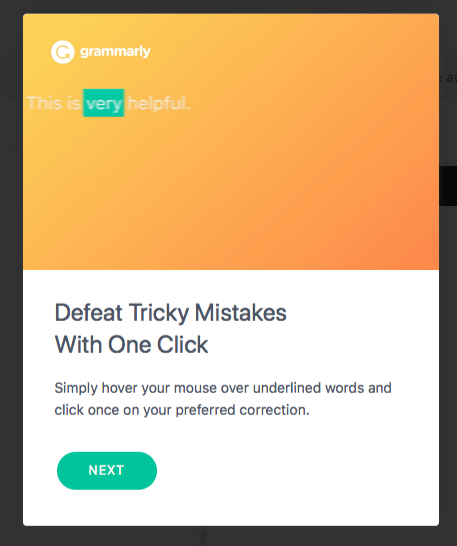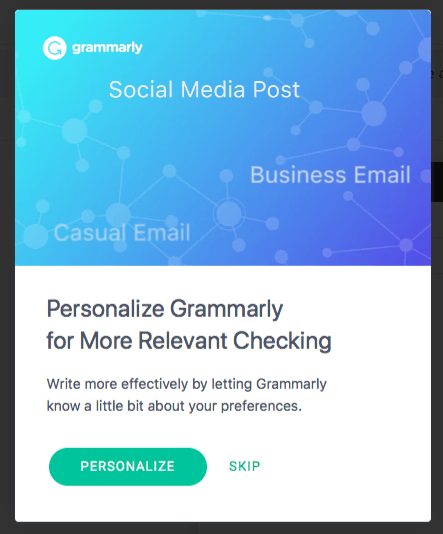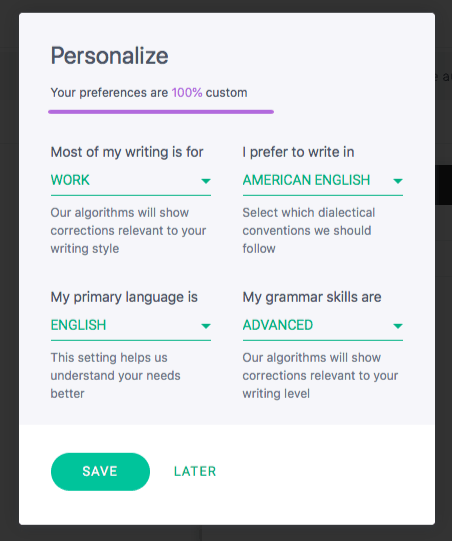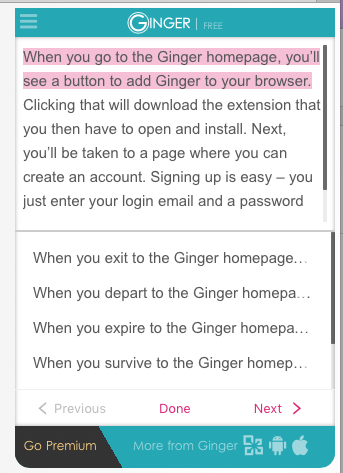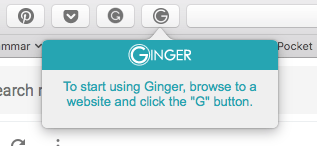- Main Differences Between Grammarly vs Ginger
- What is Writing Enhancement Software?
- What to Look for in Writing Enhancement Software
- What is Grammarly?
- Using Grammarly
- Grammarly Pricing
- Grammarly Pros and Cons
- What is Ginger?
- Using Ginger
- Ginger Pricing
- Ginger Pros and Cons
- Final Verdict: Grammarly vs Ginger
- FAQs
- Grammarly vs Ginger: Bottom Line
There are all sorts of writers in the world.
Novice writers who want to improve swiftly so they can start charging for their services. Business owners who know they need to piece clear, correct copy together but need a trained eye to help them. Professional writers who get hung up in certain problem areas time and time again.
When you don’t want to hire a live editor, turning to edit software and grammar checking software is the next best thing. MS Word alone doesn’t really cut it.
In this article, we’ll start by explaining what writing enhancement checker software is and what you should look for when shopping around. Then, we’ll give you an overview of two writing enhancement tools: Grammarly and Ginger.
Next, we’re going to dive into the experience of using both tools so that we can compare them and pick out their biggest differences. Lastly, we’ll give you our final verdict and recommendations.
Bottom Line Up Front:
Go with Grammarly here over Ginger, or look for another tool that has easy-to-use features that help you with the writing situations you struggle with.
Main Differences Between Grammarly vs Ginger
The main differences between Grammarly vs Ginger are:
- Grammarly offers a Mac desktop app, whereas Ginger does not have a Mac compatibility
- Grammarly offers a plagiarism checker tool, whereas Ginger does not have a plagiarism checker
- Grammarly is generally more convenient to use compared to Ginger
- Grammarly is slightly more expensive compared to Ginger
What is Writing Enhancement Software?
The most basic way to think of writing enhancement software is as an editing tool that will check your spelling and grammar. Today’s writing enhancement technology, though, does a lot more than that.
It has a host of resources, technologies, and tools that will help you not just write accurately, but also clearly, interestingly, and, overall, well.
Writing enhancement software does just that: enhances your writing.
What to Look for in Writing Enhancement Software
Since there are so many differences in the grammar checker software available today, the best start is to figure out what you – and you specifically – need.
Where are your problem areas?
- Do you feel like your writing flows and connects with readers, but you make the same grammar and writing mistakes over and over? A straightforward text checker may be the best, and least expensive, option.
- Do you feel like you’re a perfectionist when it comes to writing mechanics but your storytelling or readability could be improved (e.g. using passive voice too much)? You may want a more holistic tool that will pinpoint these problem areas based on phrasing and sentence length.
- Or, you may fall somewhere in the middle, feeling like you need a bit of help on both ends or an extra set of eyes (digital ones) to see where you’re repeating the same word over and over or where you’re using too many adverbs.
When comparing Grammarly and Ginger for yourself, and even when searching around for another writing enhancement tool that may be a better fit, keep your specific software checking needs, strengths and weaknesses in mind.
What is Grammarly?
Grammarly is writing enhancement software that you can use via the website, as a browser extension, or as an app that you download to your computer.
It helps improve your writing in a number of ways by flagging grammatical mistakes and areas of improvement, ranging from the basic to the more advanced.
Grammarly Signup and Setup
Creating an account is free, and all you have to do is enter your email address, password and first name. The signup page is here, but I got to it by first installing the Safari extension.
The first thing that happens is you have the choice between a free version or a premium account. We’ll get more into the differences between these accounts and pricing later, but here’s a basic overview:
One of the first things I noticed when I signed into Grammarly was how much the dashboard differs in appearance from the homepage.
Here’s the dashboard:
And here’s the homepage:
The homepage looks fresh and modern, but the dashboard looks kind of depressing. This doesn’t necessarily impact performance, but it does lessen the user experience a bit.
Using Grammarly
There are a few different ways to use Grammarly, including using the tool from your web browser, using the browser extension, or using an app that you download to your computer.
Browser
I started with the demo document that Grammarly provides. It already has a number of mistakes that you can play around with to get used to the tool.
I clicked “Correct with Assistant” on the top right and this is what came up:
If you hover over the green box, it’ll tell you what has to be changed, and then you can click it to apply the change automatically.
On the right, you can choose the problem area to work on at the moment: spelling (spell checker), grammar (english grammar), punctuation or conventions. Conventions check spacing, capitalization and dialect-specific spelling (helpful, even if just as suggestions), all very easy things to miss (especially spacing).
You can also choose Set Goals to tell Grammarly more about the document you’re working on.
I chose Describe under the Intent category and Informal under Style. While you may not see any changes in the general categories, you may see more alerts in the Premium category, which covers things like formatting, misplaced words and word choice.
If you click Insights, you get a report about your document, which you can download as a PDF if you want.
Other features include a plagiarism checker and sending your document to an actual person for proofreading.
Browser Extension
The extension flags mistakes and runs proofreading as you type to ensure that the documents (such as Google Docs or Microsoft Word / MS Word), messages and social media posts you draft online are error-free. I decided to try it out on my email. Since it was my first time using it, it walked me through the process.
I had the option to personalize how the app conducts proofreading of my writing.
When using the Grammarly extension app, you’ll see the green logo if there aren’t any mistakes.
First, I wrote an error-free email. The green logo spun as I was writing and flagged the word “your” before I was finished with the sentence, but then quickly un-flagged it when it realized I had used the correct “your.” Then, I went back and purposely added some errors to the email.
I was surprised that only one mistake was flagged. I turned “The” into “Tha,” which I guess could be considered slang. I also made the “g” at the beginning of a sentence lowercase, and I added “thx” to the end. The misspelled “yur” was the only error it flagged, though.
If you click on the corrected word in green, it will automatically correct the text for you, and then you can go back to the web page.
Next, I wanted to see how the Grammarly Mac app worked.
App
The first thing I did was bring up the demo document I’d been working on in the browser.
It didn’t have any of the corrections I made, but since I was pretty sure the documents would sync (whether in Google Docs or elsewhere), I wanted to test it out with one of my own. I was right – it immediately synced, both when I added the document and when I made changes to it.
Other than simply being another way to access Grammarly, the app worked in the same way as it did on the Grammarly website.
Grammarly Pricing
Grammarly Pros and Cons
Pros
- Signing up for Grammarly and getting started with it is super easy.
- Even though the dashboard itself, where your articles are stored, isn’t very visually appealing, the area where you work on your articles is a lot nicer, exactly what you’d expect after seeing the homepage.
- With the browser extension, you can get help for your regular day-to-day writing, like emails and social media posts, whether or not you produce longer types of content.
- Having a built-in plagiarism detector (with Premium) is extra helpful for writers who use a lot of resources to dig up information. It’s possible to accidentally plagiarize when rewording ideas and info you found online, so this will save you from turning in “illegal” copy.
- Works as a drag and drop editor for MS Word and a built-in editor with Google Docs
Cons
- Depending on the type of writing help you need, you may not get nearly enough features with the free version of the service, and there isn’t a free version trial right now for the Premium subscription.
- The biggest con I experienced is that I didn’t agree with the corrections it did and did not make. For example, when I uploaded my own document, it corrected informal wording, even though when I used the browser extension to check my email, it didn’t flag informal wording or even a capitalization error. Also, it told me to use an Oxford comma, even though I prefer to not use a serial comma and my sentence wasn’t wrong without it.
What is Ginger?
Ginger is a writing enhancement tool that’s primarily a grammar checker. It will correct text as you type, picking up on errors with punctuation, sentence structure, subject-verb agreement, writing style and wording.
Additional features include dictionary definitions, sentence rephraser to find a better way to say what you’re trying to say, synonyms, and translation to 50 different languages.
Ginger Signup and Setup
When you go to the Ginger homepage, you’ll see a button to add Ginger to your browser. Clicking that will download the extension that you then have to open and install.
Next, you’ll be taken to a page where you can create an account. There is no Mobile app (e.g. Android and iOS) or Desktop app or Desktop version per se, as it’s all cloud based. Signing up is easy – you just enter your login email and a password.
Using Ginger
Browser
The website interface is super basic and outdated, and it takes up just a small part of the web page, which is odd.
I copied and paste some text in the box and then went through it to add grammatical, spelling and punctuation errors. When I accidentally clicked on part of the web page that wasn’t in the box, though, the entire Ginger grammar checker page went blank.
I hit refresh and got the text box back, but it was blank. I tried again by entering new text. This time, it caught an error and highlighted it under suggestions. However, the suggested fix was strange.
I had started a sentence with Next you’ll and Ginger noticed that I needed a comma after next. The suggestion, though, showed me to change it to Next, you, not Next, you’ll, which I didn’t want. I clicked it anyway and it did change it to Next, you’ll, but I wouldn’t have known that until I clicked it.
Then I purposely added a couple of mistakes, like leaving the period off the last sentence and adding a partial sentence as a new paragraph. Ginger didn’t catch these mistakes at all, though, not even when I clicked the button to check it.
I wanted to explore the other features, so I clicked the feather icon on the bottom of the window. This brought up a few different ways to reword the sentences. The problem is that because this window is so tiny, I could only see the beginnings of the alternative sentences.
At this point, I accidentally clicked off the box again and lost my text. When I refreshed and got back to the box, I entered new text and clicked the star icon to see what would happen.
This added this copy to my favorites, which I can then access by clicking the menu button on the top left of the window.
Browser Extension
Thoroughly frustrated with the website version, I decided to give the browser extension a try to see if there’s any improvement.
I went to my Gmail and clicked the Ginger extension, which brought up this message:
I didn’t know what “browse to a website” meant, and I wanted to use Ginger with Gmail, which is the page I was currently on.
I typed an email with an error, but nothing happened. (I want to mention here that Grammarly immediately started flagging errors, even though I wasn’t logged in anymore, and I had to actually disable Grammarly to make it stop. Yet the tool I was trying to test, Ginger, didn’t doing a thing.)
I clicked the Ginger extension again, but it just gave me the same message. I went to Google to see if it would help at all. I clicked the extension again and that little window popped up.
Now that tiny window makes more sense, but boy did it take a long time to start figuring it out.
Also, it doesn’t make too much sense, because I’d have to start writing in the box, have it catch mistakes and correct my writing, and then copy and paste it to wherever I actually want the copy to go. That’s an extremely clunky way to write.
Also, the same thing happened here as before – if I clicked anywhere on the Google homepage, it closed the Ginger window, and when I got it back (by clicking the extension again), my text was gone.
Honestly, I’m trying hard to figure out what the point of this is, but I can’t.
Ginger Pricing
Ginger grammar is freemium checker software to start, but also offers enhanced paid options.
Ginger Pros and Cons
I can’t find any benefit of Ginger. Maybe some of the features would be useful, like sentence rephrasing or translation, but the tool is such a pain to use that it’s not worth even getting to that point.
Ginger’s interface is not nearly as nice as Grammarly’s. The homepage isn’t 100% responsive and the website tool is strange, right from when you sign up for an account:
Using that tiny little window on your browser to enter text and make all of your changes is ridiculous, and it’s incredibly frustrating that if you click off that window on another part of the web page – which is easy to do because the window takes up such a small part of it – you lose what you were working on.
If you want to write copy for, say, an email or a Facebook post, you can’t start to write it on the actual platform and have Ginger automatically check it, like with Grammarly.
You have to write it in the little Ginger window that pops up on the web page, which may have seemed convenient 10 years ago but now just gets in the way and makes the whole writing process longer.
Final Verdict: Grammarly vs Ginger
I loved the Grammarly interface, the easy setup and use, and how fast is synced across the different platforms. Since the type of corrections were so varied, though, I wouldn’t use this for online writing that I want to be perfected (I don’t like my emails to be informal) or types of copy that I want to use some creativity in.
Actually, Grammarly would work better for me if those two things were switched: if it was more diligent about scanning writing with the browser extension and less by-the-book when using the grammar software on the website or app editor.
Grammarly is best for academic writing or business blogging (with a great built-in plagiarism check) that doesn’t have much wiggle room for inventiveness or if you have the same problem over and over (like spell check and advanced grammar issues) that you need some training to correct.
When it comes to Ginger, I can’t find any redeeming qualities.
It’s hard to figure out how to use, too small to easily make changes to the copy and it has a totally inconvenient way of checking your copy when writing for an online platform. You’d be better off going with something free to start like the Hemingway App.
Also, the fact that you lose your copy if you click on another part of the page is completely ridiculous.
FAQs
Answer: Yes, Grammarly is one of the best tools you can find that will help you fix any typos in your texts, it will show you any grammar mistakes, spelling, and even words that are missing once you have started writing.
Answer: Grammarly is a simple tool that can be used as an extension to Chrome, which is way easier when you want to work on something online, so once the software notices something is wrong, you will get a red underlined word, and suggestions of how to fix it. Also, you can open the icon down below your final text, and you can notice if the text has additional errors or plagiarism.
Answer: Yes, Ginger works with more than 40 other languages than English and it also provides translation from English to a chosen language and vice versa.
Answer: No, so far Ginger detects any errors in English, but provides a translation in 40 different languages which some users don’t appreciate a lot, as they can’t know if there are any mistakes made during the translation.
Grammarly vs Ginger: Bottom Line
Go with Grammarly here over Ginger, or look for another tool that has easy-to-use features that help you with the writing situations you struggle with.
- AutoCrit Review for Online Writers - April 20, 2023
- Grammarly vs Ginger: Which is Best? - April 20, 2023














